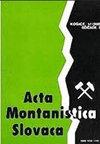Role of Information Communication Technologies Regarding Employment Aspect in Mining Industry
IF 1.4
4区 地球科学
Q2 GEOSCIENCES, MULTIDISCIPLINARY
引用次数: 0
Abstract
The information and communications technologies represent a significant field in each sector of the economy. Currently, they are very rapidly growing means that bring new aspects in the particular industrial sectors. Employment is a very important perspective here. As the mining industry belong to the primary sector of the economy, it represents an essential part in a form of the first input branches. Nowadays, the information and communications technologies bring to the forefront novel methods and approaches that have been gradually becoming significance. The explored area covers all the 27 European Union member countries dated to the year 2020. The data set comprises the time period from the year 2008 to the year 2020. Employment in the mining industry from a view of the information and communications technologies is understood in the two ways – as a manufacturing side and as a side of the services offered here. Moreover, the altogether perspective is illustrated too. The nature of the data is investigated through the Jarque-Bera test, while the main analytical technique is the correspondence analysis. The scrutinised member countries of the European Union demonstrate the various development in the employment from a view of the information and communication technologies in the mining industry as a part of the primary sector of the economy.信息通信技术在矿业就业中的作用
信息和通信技术在每个经济部门中都是一个重要的领域。目前,它们的发展非常迅速,意味着在特定的工业部门带来新的方面。就业是一个非常重要的视角。采矿业属于第一经济部门,是第一投入部门的重要组成部分。如今,信息和通信技术带来了新的方法和途径,并逐渐变得重要。勘探区域涵盖了截至2020年的所有27个欧盟成员国。该数据集的时间段为2008年至2020年。从信息和通信技术的角度来看,采矿业的就业可以从两方面理解- -作为制造业方面和作为这里提供的服务方面。此外,还说明了整体视角。通过Jarque-Bera检验来考察数据的性质,而主要的分析技术是对应分析。从作为主要经济部门一部分的采矿业的信息和通信技术的角度来看,欧洲联盟的审查成员国显示了就业方面的各种发展。
本文章由计算机程序翻译,如有差异,请以英文原文为准。
求助全文
约1分钟内获得全文
求助全文
来源期刊

Acta Montanistica Slovaca
地学-地球科学综合
CiteScore
3.60
自引率
12.50%
发文量
60
审稿时长
30 weeks
期刊介绍:
Acta Montanistica Slovaca publishes high quality articles on basic and applied research in the following fields:
geology and geological survey;
mining;
Earth resources;
underground engineering and geotechnics;
mining mechanization, mining transport, deep hole drilling;
ecotechnology and mineralurgy;
process control, automation and applied informatics in raw materials extraction, utilization and processing;
other similar fields.
Acta Montanistica Slovaca is the only scientific journal of this kind in Central, Eastern and South Eastern Europe.
The submitted manuscripts should contribute significantly to the international literature, even if the focus can be regional. Manuscripts should cite the extant and relevant international literature, should clearly state what the wider contribution is (e.g. a novel discovery, application of a new technique or methodology, application of an existing methodology to a new problem), and should discuss the importance of the work in the international context.
 求助内容:
求助内容: 应助结果提醒方式:
应助结果提醒方式:


